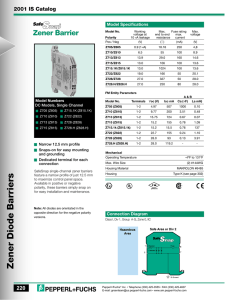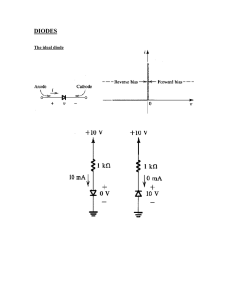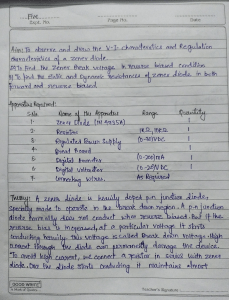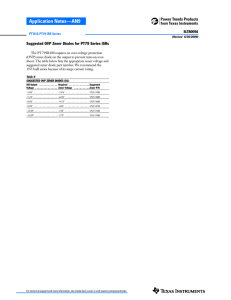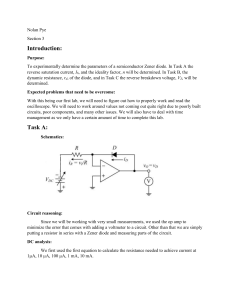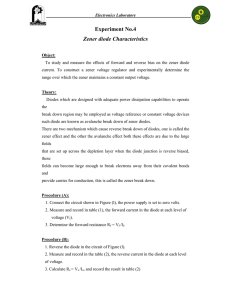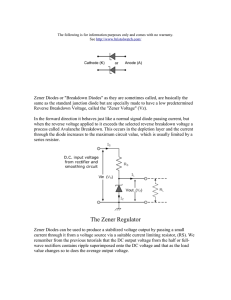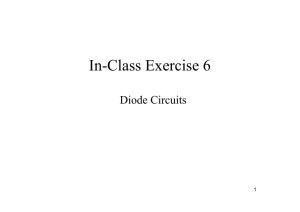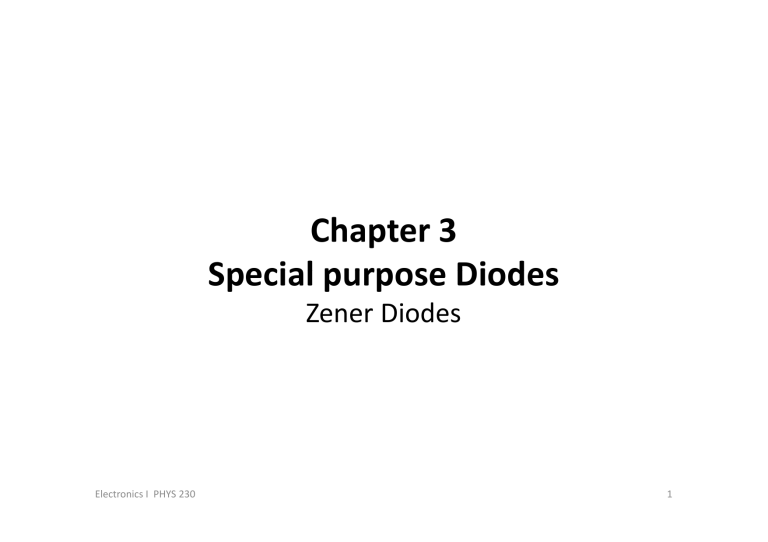
Chapter 3 Special purpose Diodes Zener Diodes Electronics I PHYS 230 1 Obj ti Objectives ¾ Describe the characteristics of a zener diode and analyze its operation ¾Find the equivalent circuit of the zener diode by using: a)) The ideal diode model b) The practical diode model Electronics I PHYS 230 2 3.1 Zener Diodes ¾A zener diode is a Si pn Junction ¾Zener Diode is designed for operation in the reverse region ¾The breakdown voltage is controlled carefully by controlling the doping level The symbol for a zener diode Electronics I PHYS 230 3 Zener Diodes Forward characteristics are just like a normal diode. ¾The normal operation regions for a rectifier diode are shown as shaded area. ¾The normal operation region for a Zener diode is shown as shaded area. ¾Zener diode is designed to operate in reverse breakdown ¾The zener diodes breakdown characteristics are determined by the doping process. Electronics I PHYS 230 ¾Available with VBR = 1.8 V – 200 V 4 Breakdown Characteristics VZT A Zener diode operating p g in the breakdown act as a voltage regulator because it maintain nearly a constant voltage ¾The reverse current IR is called IZ ¾The curve illustrates the minimum (IZK) and maximum (IZM) ranges g of current operation p that the zener can effectivelyy maintain it’s voltage. ¾Below the zener knee, the zener breakdown voltage (VZ) remain almost constant as the current increase. Electronics I PHYS 230 5 Zener Equivalent Circuit a) Ideal Model: VZ IR Ideal characteristics curve ¾Zener diode is represented by a dc voltage source ¾Zener diode does not produce an emf voltage ¾The diode does not have any internal resistance Electronics I PHYS 230 6 Zener Equivalent Circuit b) Practical Model ∆VZ ZZ = ∆I Z ¾Zener diode is represented by a dc voltage source and a resistance which is called zener impedance (ZZ) ¾A change in the current (∆IZ) produces a small change in the voltage (∆VZ) ¾By Ohm’s law, the ratio of ∆VZ to ∆IZ is the resistance ZZ Example 3.1: What is the zener impedance (ZZ)? Electronics I PHYS 230 8 Zener Voltage Calculation (Practical Model): if I Z < I ZT then, VZ = VZT − ∆VZ VZ = VZT + Z ZT × ( I Z − I ZT ) ⇒ VZ < VZT if I Z > I ZT then, VZ = VZT + ∆VZ VZ = VZT + Z ZT × ( I Z − I ZT ) ⇒ VZ > VZT Example 3.2: A zener diode has a ZZT of 3.5 Ω. The data sheet gives VZT = 6.8 V at IZT = 37 mA and IZK = 1 mA. What is the voltage across the zener terminals when the current is 50 mA? When the current is 25 mA? ± ∆Vz Temperature Coefficient (TC) TC specifies the percent change in VZ for each degree centigrade change in temperature. ∆VZ = VZ × TC × ∆T Where: TC is the temperature coefficient VZ is the zener voltage at RT (25°C) ∆T is the change in temperature +ve TC means that VZ increases with increasing temperature or d decreases with ith decreasing d i ttemperature t ‐ve TC means that VZ increases with decreasing temperature or decreases with increasing temperature Example 3.3: TC= 0.05% / °C, T changed from 25 to 60°C, VZ = 8.5V at 25°C. What is VZ at 60°C ? Electronics I PHYS 230 11 Zener Power Dissipation Zener diodes are specified to operate at a maximum power called the maximum dc p power dissipation p PD(max). ( ) The p power dissipation p is given by: PD = VZ I Z Therefore, I ZM PD (max) ≅ VZ Zener Diode Data Sheet Review ¾Zener diode normally operates in the reverse region ¾Zener diode is used as a voltage regulator because VZ remains almost constant as the current increase ¾The zener impedance p causes the voltage g to varyy slightly g y ∆V Z ZZ = ∆I Z ¾TC specifies the percent change in VZ for each degree centigrade change in temperature. ∆VZ = VZ × TC × ∆T ¾The power dissipation in a zener diode is given by Electronics I PHYS 230 PD = VZ I Z 14
